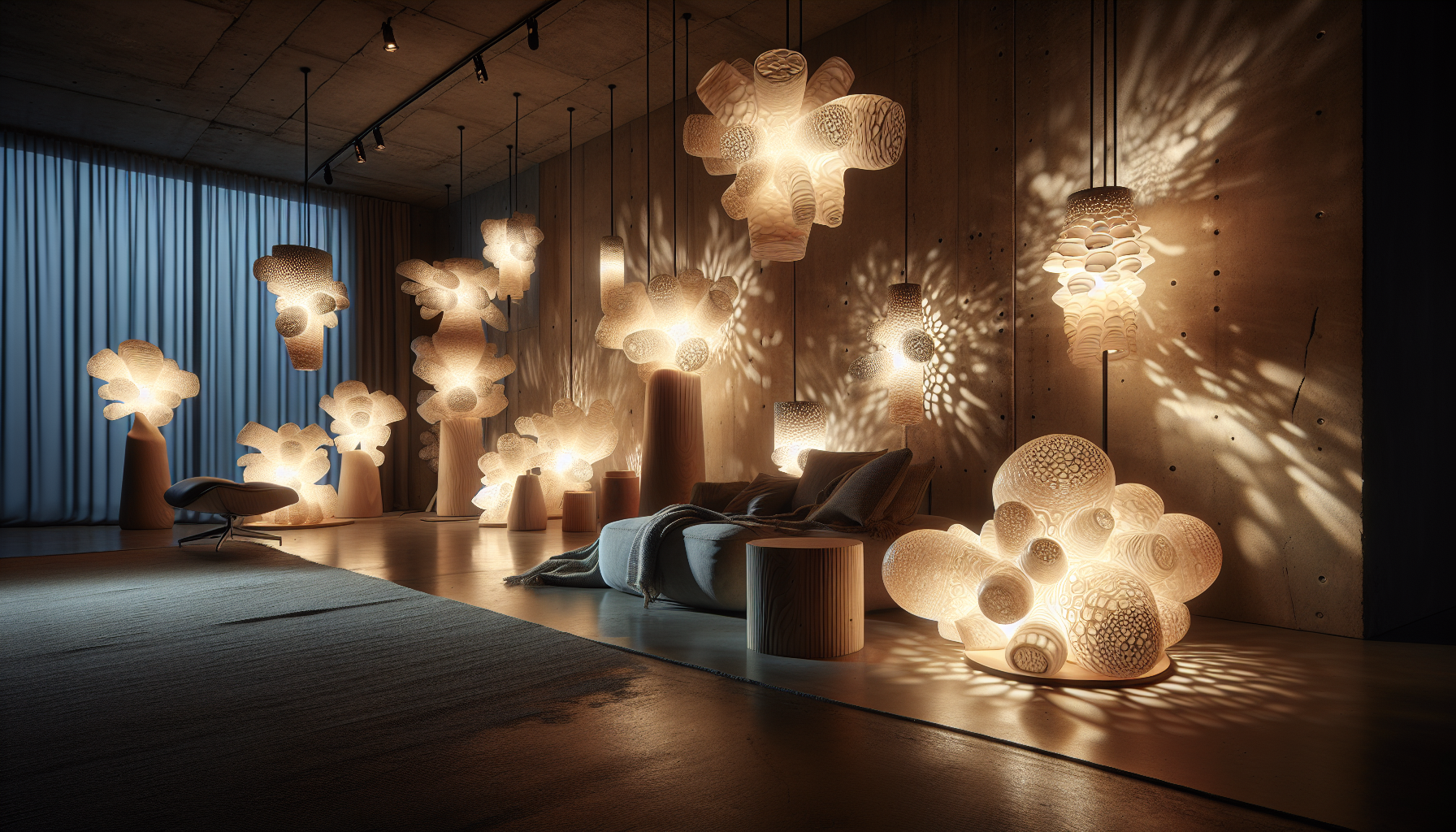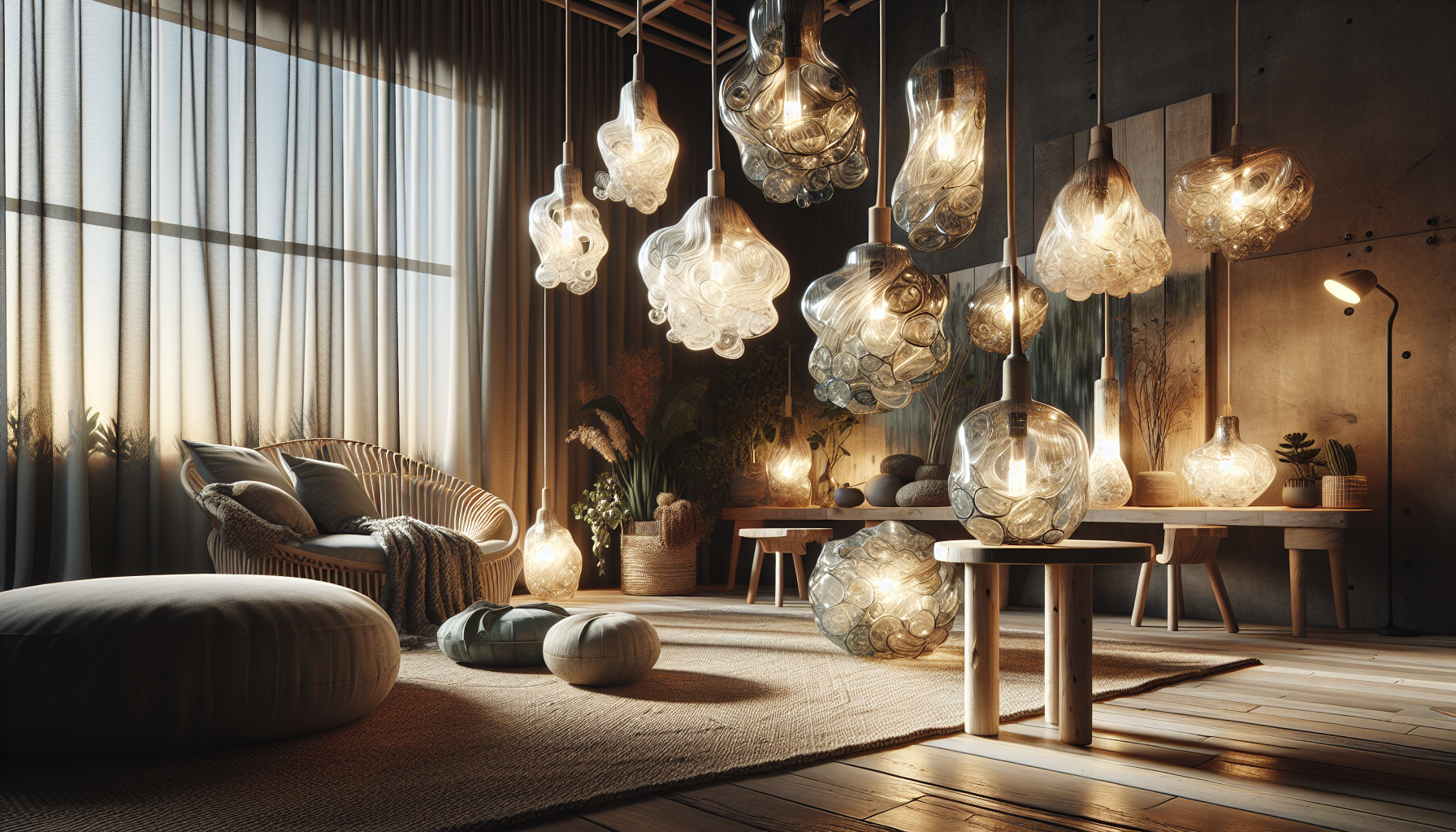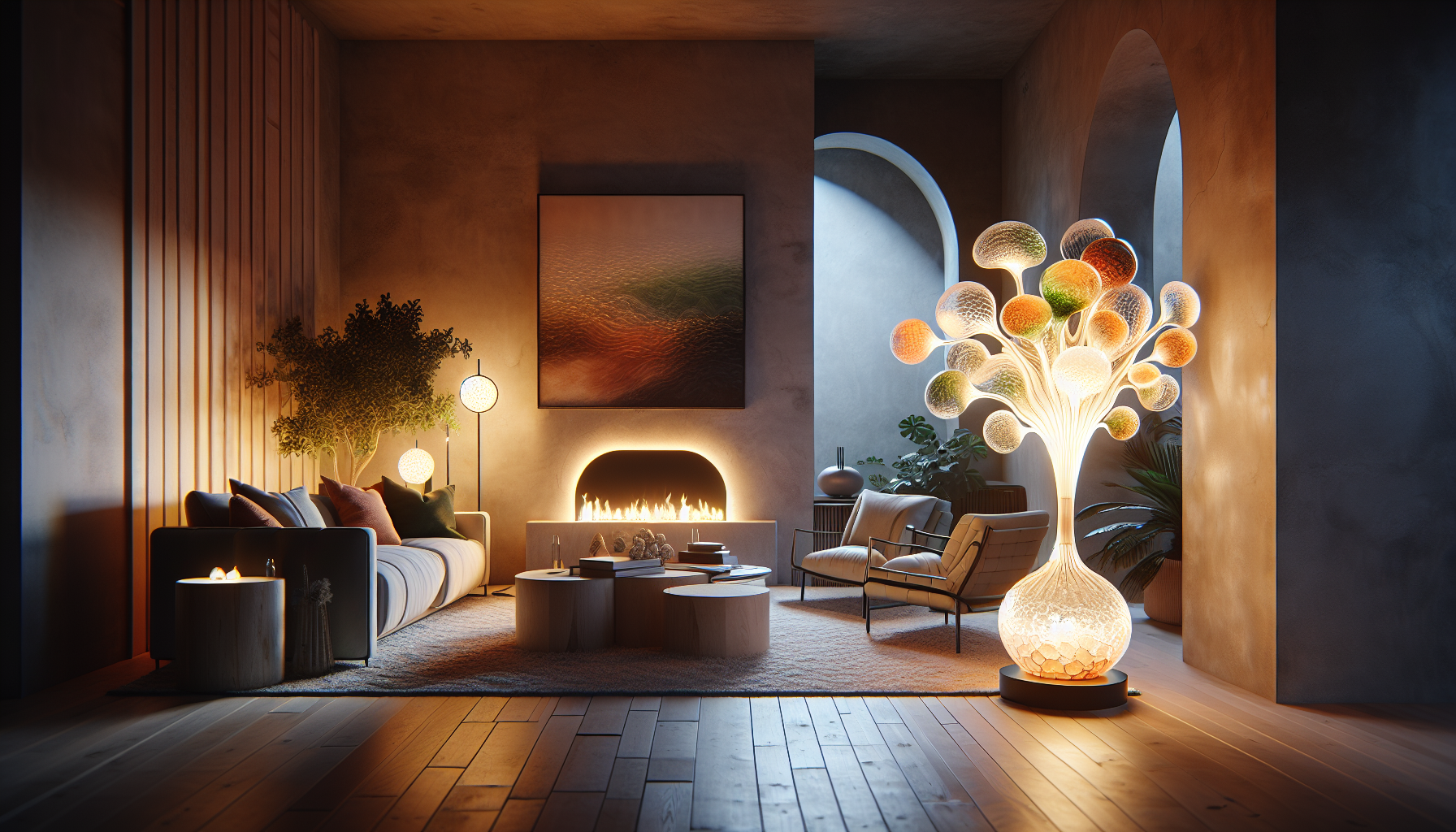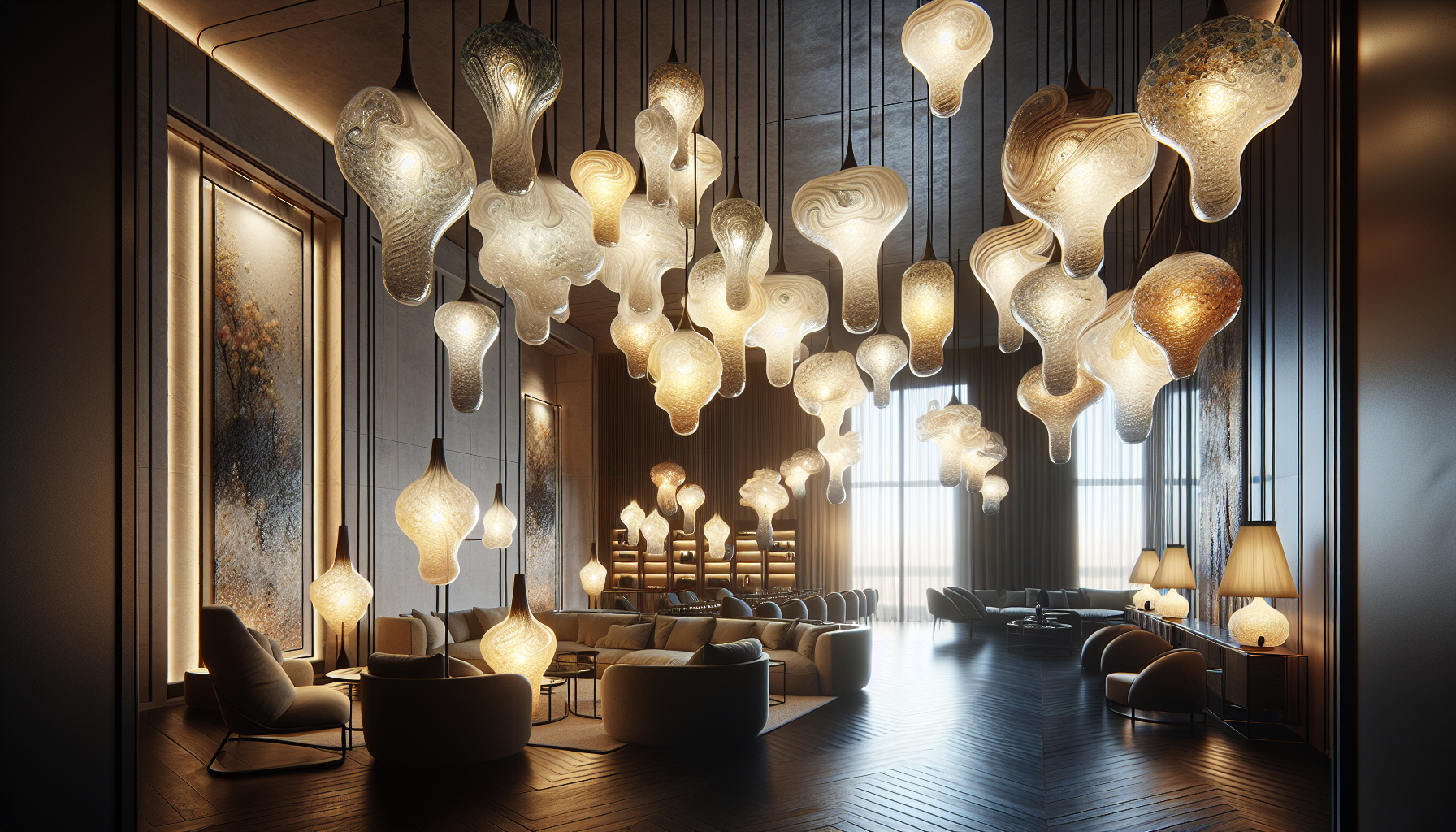In a world increasingly driven by the principles of sustainability and environmental consciousness, the demand for creative solutions that marry function with ecological responsibility has never been more critical. As we navigate this new era, the arts and crafts sector is undergoing a renaissance, breathing new life into materials that were once deemed disposable. One of the most captivating manifestations of this movement is the emergence of sculptural lamps crafted from recycled glass bottles. These luminous creations not only illuminate our physical spaces but also shine a light on the endless possibilities of upcycling, inviting us to reconsider what we discard and how we perceive beauty. 🌿
Imagine walking into a room where the atmosphere is transformed by the gentle glow of a lamp that tells a story—a story of rebirth, creativity, and innovation. Artisanal glass lamps, meticulously crafted from recycled bottles, are becoming the focal point in interior design, offering more than just illumination. They are conversation starters, pieces of art that encapsulate the spirit of sustainability. In this article, we will explore the fascinating journey of how discarded glass bottles are reborn as breathtaking sculptural lamps, highlighting the artisans who dedicate their craft to this transformative process.
To fully appreciate the artistry behind these stunning pieces, we must delve into the intricate process of glass recycling and the craftsmanship required to transform simple bottles into elegant luminaires. We’ll uncover the techniques employed by skilled artisans who cut, shape, and mold glass with precision and care, turning waste into wonder. Additionally, we will explore the diverse styles and designs available, from minimalist aesthetics that emphasize form and function to elaborate creations that pay homage to traditional glass-blowing artistry. Each lamp is a unique testament to the creativity and skill of its maker, offering a distinct charm that resonates with eco-conscious consumers.
Moreover, this exploration would be incomplete without addressing the broader environmental impact of upcycling glass. We’ll examine how this practice contributes to reducing landfill waste and conserving natural resources, ultimately promoting a more sustainable lifestyle. The journey of a glass bottle from recycling bin to the centerpiece of your living room is not just about aesthetics; it is a powerful statement about responsibility and change. Through interviews with designers and eco-advocates, we’ll gain insight into the motivations and challenges faced in promoting sustainable art and why it matters in today’s world.
Join us as we illuminate the transformative power of artisanal glass lamps, guiding you through a narrative that combines art, sustainability, and innovation. Whether you’re an interior design enthusiast seeking to infuse your home with character or an eco-warrior committed to supporting green initiatives, this deep dive into the world of sculptural lamps from recycled bottles will inspire and enlighten. Let us embark on this journey of rediscovery, where beauty meets responsibility, and where every glow signifies a step towards a brighter, more sustainable future. 💡
The Rise of Artisanal Glass Lamps: A Sustainable Revolution
In recent years, there has been a significant shift in consumer preferences towards sustainable and eco-friendly products. This trend has permeated various industries, including interior design and home décor, where artisanal glass lamps made from recycled bottles are gaining popularity. These sculptural lamps not only illuminate spaces but also serve as a testament to the creativity and resourcefulness of artisans who transform discarded materials into beautiful and functional pieces of art. The use of recycled glass in lamp making is a prime example of upcycling, where waste materials are repurposed into higher-value products, reducing environmental impact and promoting sustainability.
The process of creating artisanal glass lamps involves skilled craftsmanship and a deep understanding of glass as a material. Artisans meticulously select and clean recycled bottles, cutting and shaping them to form unique designs. Each lamp is handcrafted, making it a one-of-a-kind piece that adds a personal touch to any space. This labor-intensive process highlights the dedication and expertise of artisans, who often draw inspiration from nature and their surroundings to create designs that resonate with a wide audience. The result is a stunning array of lamps that not only provide illumination but also serve as captivating conversation starters.
Moreover, the use of recycled glass in lamp making has several environmental benefits. By repurposing bottles that would otherwise end up in landfills, artisans contribute to reducing waste and conserving natural resources. The energy required to melt and shape recycled glass is significantly lower than that needed to produce new glass, resulting in a smaller carbon footprint. As consumers become more environmentally conscious, the demand for sustainable products like artisanal glass lamps is expected to rise, further driving innovation and creativity in the industry.
Comparative Analysis: Artisanal Glass Lamps vs. Traditional Lamps
When it comes to choosing lighting fixtures, consumers often find themselves comparing artisanal glass lamps with traditional lamps made from conventional materials. The differences between these two types of lamps are not only aesthetic but also functional and environmental. Understanding these differences can help consumers make informed decisions that align with their values and preferences.
Firstly, artisanal glass lamps offer a unique aesthetic appeal that is often unmatched by traditional lamps. The handcrafted nature of these lamps ensures that each piece is unique, with its own set of colors, textures, and shapes. This distinctiveness allows homeowners to express their personal style and add character to their living spaces. In contrast, traditional lamps, which are often mass-produced, lack the individuality and charm of their artisanal counterparts. While they may offer a more uniform look, they often fail to make a statement or serve as a focal point in a room.
From a functional perspective, artisanal glass lamps provide versatility in terms of lighting and design. They can be used as ambient lighting, task lighting, or accent lighting, depending on the design and placement. The transparency and reflectivity of glass also allow for creative lighting effects, enhancing the ambiance of a room. On the other hand, traditional lamps may offer more standard lighting options, but they lack the flexibility and creativity that come with artisanal designs.
FeatureArtisanal Glass LampsTraditional LampsAesthetic AppealUnique, handcrafted, personalizedMass-produced, uniformEnvironmental ImpactEco-friendly, made from recycled materialsHigher carbon footprint, often uses new materialsFunctionalityVersatile, creative lighting effectsStandard lighting options
One of the most significant advantages of artisanal glass lamps is their environmental impact. As mentioned earlier, these lamps are made from recycled materials, which helps reduce waste and conserve resources. In contrast, traditional lamps often use new materials, contributing to a larger carbon footprint. For eco-conscious consumers, the choice between these two types of lamps is clear: artisanal glass lamps offer a more sustainable and responsible option.
Creating Art from Discarded Bottles: The Artisanal Process
The journey from discarded bottle to stunning artisanal lamp is a fascinating process that combines creativity, skill, and innovation. Each step in the process is carefully executed to ensure the final product is both functional and aesthetically pleasing. This section delves into the intricate process of transforming recycled bottles into beautiful lamps, highlighting the artistry and dedication involved.
Firstly, artisans begin by sourcing and selecting suitable bottles for their projects. These bottles are typically collected from local recycling centers, bars, and restaurants, where they would otherwise be discarded. The selection process is crucial, as the size, shape, and color of the bottle can significantly influence the final design of the lamp. Artisans often choose bottles that offer unique shapes or colors, providing a solid foundation for their creative vision.
Once the bottles are selected, the next step is cleaning and preparing them for transformation. This involves removing labels, adhesives, and any other contaminants that could interfere with the glass-cutting process. Artisans use specialized tools and techniques to carefully cut and shape the glass, ensuring precision and safety throughout. This stage requires a steady hand and a keen eye for detail, as even the slightest error can impact the overall design of the lamp.
After the glass is cut and shaped, artisans move on to the assembly stage, where the lamp begins to take form. This involves combining the glass components with other materials, such as metal or wood, to create a cohesive design. Artisans often use soldering techniques to join the pieces together, ensuring stability and durability. At this stage, creativity truly comes into play, as artisans experiment with different configurations and arrangements to achieve their desired look.
The Final Touches: Adding Light and Life
With the lamp structure complete, the final step is to add the lighting element, which brings the piece to life. Artisans carefully select and install lighting fixtures that complement the overall design, ensuring optimal illumination and ambiance. This stage involves a thorough understanding of lighting principles, as well as an appreciation for aesthetics and functionality.
Once the lamp is fully assembled, artisans conduct rigorous testing to ensure it meets safety standards and functions as intended. This involves checking the electrical components, stability, and overall durability of the piece. Only after passing these tests is the lamp deemed ready for sale and display.
To gain a deeper understanding of this creative process, watch this insightful video: “The Art of Recycled Glass Lighting” by Artisans of Light on YouTube. 🎥
Incorporating Artisanal Glass Lamps into Your Space
Artisanal glass lamps offer endless possibilities for enhancing interior spaces, thanks to their unique designs and versatility. Whether you’re looking to create a cozy reading nook, a vibrant living room, or an elegant dining area, these lamps can serve as the perfect centerpiece or accent piece to tie the room together.
When incorporating artisanal glass lamps into your space, consider the overall style and color scheme of the room. The lamp’s design should complement and enhance the existing décor rather than clash with it. For instance, a lamp with a bold, colorful design may be best suited for a modern, eclectic space, while a more understated piece may work well in a minimalist or traditional setting. Additionally, consider the scale of the lamp in relation to the room’s size and layout. A large, statement piece may overwhelm a small space, while a smaller lamp may get lost in a larger area.
Lighting placement is another critical factor to consider when integrating artisanal glass lamps into your home. These lamps can be used to create various lighting effects, from soft, ambient lighting to focused task lighting. Consider the lamp’s intended function and adjust its placement accordingly. For example, a lamp used for reading should be placed near a comfortable chair or sofa, while a piece intended to serve as ambient lighting may be positioned in a central location to evenly distribute light throughout the room.
- Identify the style and color scheme of your room to ensure the lamp complements the décor.
- Consider the scale of the lamp in relation to the room’s size and layout.
- Determine the lamp’s intended function and adjust its placement accordingly.
- Experiment with different lighting effects to create the desired ambiance.
As you explore the possibilities of incorporating artisanal glass lamps into your space, allow your creativity to guide you. These unique pieces offer a chance to express your personal style and create a warm, inviting atmosphere that reflects your values and aesthetic preferences. Embrace the opportunity to illuminate your space with art, and enjoy the beauty and functionality that artisanal glass lamps bring to your home.

Conclusion
In conclusion, the exploration of artisanal glass and its transformation into sculptural lamps made from recycled bottles offers a unique intersection of art, sustainability, and innovation. Throughout this article, we have delved into the intricate process of creating these exquisite pieces, highlighting the craftsmanship and creativity required to bring such visions to life. The journey from discarded glass to a work of art illuminates not only our physical spaces but also our understanding of the value in repurposing and sustainability.
The key points we discussed include the historical significance of glass as a medium, tracing its evolution from ancient art forms to contemporary design. We examined how modern artisans are revitalizing traditional techniques to create lamps that are not just sources of light but also narrative pieces that tell a story. By repurposing recycled bottles, these artists challenge conventional notions of waste, demonstrating the potential for beauty and function to emerge from what was once considered disposable.
Furthermore, we explored the environmental impact of such artistic endeavors. The use of recycled materials not only reduces waste but also lessens the demand for new raw materials, contributing to a more sustainable and eco-friendly production cycle. This aligns with global efforts to address climate change and promote environmental stewardship, making each lamp a beacon of hope for a greener future.
The significance of these lamps extends beyond their aesthetic appeal. They serve as a reminder of the importance of sustainable practices and the role of art in shaping cultural and environmental consciousness. By choosing artisanal glass lamps made from recycled bottles, consumers are not only acquiring a beautiful object but also supporting a movement that prioritizes the planet and its resources.
As we reflect on the themes and ideas presented, it is clear that the integration of art and sustainability offers a powerful platform for change. The sculptural lamps discussed in this article are more than just decorative pieces; they are embodiments of a commitment to innovation, environmental responsibility, and artistic expression.
We encourage you, our readers, to consider the impact of your choices on the environment and to seek out products that align with sustainable values. Share this article with friends and family to spread awareness about the importance of supporting artisans who prioritize eco-friendly practices. Additionally, we invite you to comment below with your thoughts on how art can contribute to a more sustainable world.
By embracing the beauty of artisanal glass and the ingenuity behind recycled creations, we can illuminate not only our homes but also our path towards a more sustainable and harmonious coexistence with nature. Let’s champion the artisans who inspire change and continue to explore ways in which creativity can drive sustainability.
For further reading on the environmental impact of recycling glass and innovative art forms, consider exploring these resources:
Thank you for joining us on this illuminating journey. Together, let’s make informed choices that reflect our shared commitment to a brighter, more sustainable future. 🌿💡
Toni Santos is a lighting artisan and visual explorer who designs atmospheres, not just objects. With a refined sensitivity to form, reflection, and emotion, Toni’s work at Sordux is an ode to how light transforms space, feeling, and story.
Through his handcrafted creations — from artistic glass bottles to radiant lighting totems — Toni invites us to see light as more than function. To him, light is symbolic. It is memory, energy, and meaning in motion.
Drawing inspiration from modern minimalism, ancestral aesthetics, and organic shapes, Toni blends natural materials with ambient expression. His collections are not just decorative — they’re immersive experiences, each one crafted to awaken the senses and reconnect us to the spaces we inhabit.
As the mind behind Sordux, Toni curates a world where illumination becomes ritual, and where every design element — from the curvature of a bottle to the hue of a glow — speaks of intention and presence.
🔥 His vision shines through:
-
Designs that merge mood with form
-
Bottled light as symbolic storytelling
-
Sustainable aesthetics rooted in artistic function
Whether you’re a designer, a dreamer, or someone who understands that light is a language of its own, Toni invites you into a world where glow becomes meaning, and every beam is an invitation to feel.





